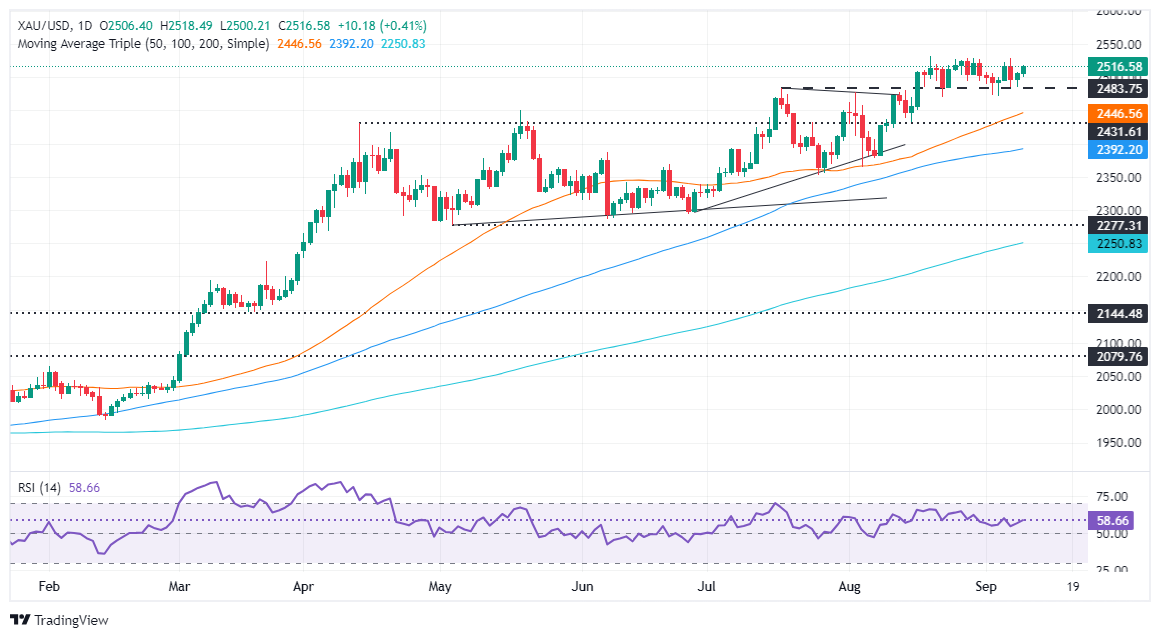Gold price edges higher as traders eye US inflation and debate

- Gold price increases as US Treasury yields drop and the US Dollar weakens.
- Traders await US CPI data; Fed rate cut odds are 67% for a 25 bps reduction and 33% for 50 bps.
- Focus shifts to the first US presidential debate, potentially impacting market sentiment ahead of election.
Gold prices advanced in the mid-North American session on Tuesday, gaining some 0.30% as traders braced for the crucial August inflation report from the United States (US). This, along with the first presidential debate between Vice President Kamala Harris and former President Donald Trump, could influence the financial markets. The XAU/USD trades at $2,514, bouncing off daily lows of $2,500.
The market mood has slightly improved, while the Greenback pared some of its earlier gains, a tailwind for the golden metal. US Treasury bond yields fell ahead of the latest Consumer Price Index (CPI) reading. Figures are expected to justify the Federal Reserve’s (Fed) dovish stance toward beginning a rate cutting cycle amid fears that the labor market could weaken.
The latest US jobs report revealed that the economy added fewer people to the workforce than expected, but the Unemployment Rate ticked lower, a relief for Fed policymakers.
Meanwhile, the swaps market shows the odds for a 50 bps cut have increased to 33%, while they stand at 67% for 25 bps, according to the CME FedWatch Tool. Earlier, a Reuters poll revealed that 92 of 101 economists expect the Federal Reserve (Fed) to lower interest rates by 25 basis points (bps) at the September 17-18 meeting.
Political developments should begin to gain attention before the US Presidential Election on November 5. Vice President Kamala Harris and Donald Trump will meet for their first debate on Tuesday at 21:00 ET (01:00 GMT) via ABC.
Daily digest market moves: Gold price climbs as traders eye US CPI
- Gold price advances on Tuesday as the Greenback erases its earlier gains. The US Dollar Index (DXY), which tracks the buck’s performance against six currencies, is virtually unchanged at 101.62.
- US 10-year T-note yield drops five basis points to 3.648%, reflecting traders’ positioning ahead of September 18-19.
- US August CPI is expected to decline from 2.9% to 2.6% YoY, while core CPI is projected to remain at 3.2%.
- Last week’s NFP report revealed the economy added over 142K employees to the workforce but missed consensus of 160K. However, the dip in the Unemployment Rate lent a lifeline to the Greenback.
- Last Friday, Fed officials were dovish. New York Fed President John Williams said that cutting rates will help keep the labor market balanced, while Governor Christopher Waller said that “the time has come” to ease policy.
- Chicago Fed President Austan Goolsbee was dovish, saying policymakers have an “overwhelming” consensus to reduce borrowing costs.
- It is worth noting that Fed officials entered their blackout period ahead of the Federal Open Market Committee (FOMC) monetary policy meeting.
- Data from the Chicago Board of Trade (CBOT) indicates that the Fed is anticipated to cut at least 108 basis points (bps) this year, based on the fed funds rate futures contract for December 2024.
Technical outlook: Gold price holds gains above $2,500
From a technical standpoint, XAU/USD climbs steadily yet cannot break above the all-time high of $2,531 as traders brace for a critical data release on Wednesday. Momentum shows Gold should remain trading sideways, based on the Relative Strength Index (RSI), which is almost flat.
If Gold clears the ATH, the next resistance would be the $2,550 mark. Once hurdled, the next stop would be the psychological $2,600 figure.
Conversely, if Gold price slides below $2,500, the next support would be the August 22 low at $2,470. On further weakness, the next demand zone would be the confluence of the May 20 high, which turned into support, and the 50-day Simple Moving Average (SMA) between $2,450 and $2,440.
Fed FAQs
Monetary policy in the US is shaped by the Federal Reserve (Fed). The Fed has two mandates: to achieve price stability and foster full employment. Its primary tool to achieve these goals is by adjusting interest rates. When prices are rising too quickly and inflation is above the Fed’s 2% target, it raises interest rates, increasing borrowing costs throughout the economy. This results in a stronger US Dollar (USD) as it makes the US a more attractive place for international investors to park their money. When inflation falls below 2% or the Unemployment Rate is too high, the Fed may lower interest rates to encourage borrowing, which weighs on the Greenback.
The Federal Reserve (Fed) holds eight policy meetings a year, where the Federal Open Market Committee (FOMC) assesses economic conditions and makes monetary policy decisions. The FOMC is attended by twelve Fed officials – the seven members of the Board of Governors, the president of the Federal Reserve Bank of New York, and four of the remaining eleven regional Reserve Bank presidents, who serve one-year terms on a rotating basis.
In extreme situations, the Federal Reserve may resort to a policy named Quantitative Easing (QE). QE is the process by which the Fed substantially increases the flow of credit in a stuck financial system. It is a non-standard policy measure used during crises or when inflation is extremely low. It was the Fed’s weapon of choice during the Great Financial Crisis in 2008. It involves the Fed printing more Dollars and using them to buy high grade bonds from financial institutions. QE usually weakens the US Dollar.
Quantitative tightening (QT) is the reverse process of QE, whereby the Federal Reserve stops buying bonds from financial institutions and does not reinvest the principal from the bonds it holds maturing, to purchase new bonds. It is usually positive for the value of the US Dollar.
